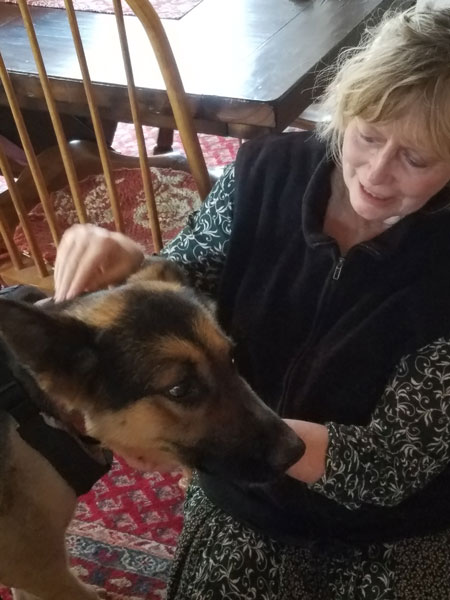
Photo courtesy Janice Murasko
On May 31, Janice Murasko received a call from Edgar Santiago at Living Free. Murasko is the director of the Animal Rescue Friends of Idyllwild, also known as ARF and Santiago is the kennel manager at Living Free Animal Sanctuary.
Santiago called Murasko to say he had a dog that could use her help. A woman in Anza found the German shepherd wandering in her back yard, called a neighbor and the neighbor brought the dog to Living Free. Santiago told Murasko the shepherd was in terrible physical shape and was cowering in fear. Those were the first Samaritans who helped save Baron’s life.
Murasko got on the phone and started calling her foster contacts. Foster people are those who volunteer to care for the found pets until a permanent owner can be found. In this case, Mallory Cremin was the next angel who agreed to foster the found dog.
Murasko named the German shepherd “Baron” because she wanted to give him “a name of nobility.” Although Baron was in terrible physical pain, with matted hair loaded with foxtails and a mangled neck, he was gentle, sweet-tempered and docile.
Murasko brought Baron to Cremin.
Murasko described how Baron responded to the two active little dogs owned by Cremin’s roommate. While the dogs barked and circled Baron, he remained perfectly quiet and still, using his gentle eyes to watch the much smaller dogs circle and surround him. Murasko remembers that the smaller dogs soon tired of the frenzy and left Baron in peace. Cremin settled him into a secluded spot on the deck at her house.
The next day, Murasko went back to visit Baron and Cremin, accompanied by Teri Hardy, a registered nurse who is also the director of Animal Welfare at ARF. The three assessed Baron’s wounds and decided he needed medical attention beyond what they could provide. The two ARF directors took Baron to the animal hospital in Banning where the veterinarian quickly determined that Baron was 15 to 20 pounds underweight and that his wounds needed surgical attention. The medical team shaved Baron to expose the open wounds along his neck so they could suture the gaping flesh. They also eliminated many of the foxtails by shaving his torso. Baron’s newly shaven look left him looking like a lion, with his head still covered in fur and one tuft left at the end of his tail.
He may have looked regal, but the surgeon described the wounds with less nobility. He noted that in addition to current open wounds on his neck, Baron had more than 100 old wounds around his neck, with scars also covering his shoulder and extending into his armpit. The surgeon explained that those wounds were consistent with dogs who are used as “bait” in dog fighting rings. The vet explained that, unfortunately, it is a common practice to use more docile dogs as “bait” to “train” the fighting dogs.
Murasko and her team went to work researching the practice of dog fights and “bait” dogs while Baron went home to Cremin’s to convalesce. Cremin kept cold compresses on Baron’s wounds and slowly removed more of the foxtails that threatened to turn infected if left in place. Cremin had help from Cyndy Zaech, vice president of ARF who is also an RN, Hardy and Murasko to remove the barbed seed heads. Murasko described how Baron never barked or even flinched during the removal of the pesky weeds. “When he couldn’t take it anymore, he just got up, walked around for a minute, then came back, and lay down in front of us so we could remove some more.”
The research on dog fights and “bait” dogs was not nearly as gentle. Murasko and her crew discovered that dog-fighting rings will often acquire docile dogs from Craig’s List or from free clinic days at animal shelters. The dogs are used to train the fighting dogs and frequently die “in the ring.” If “bait” dogs manage to survive they are commonly left along the side of a road in such bad shape that they will eventually die or be killed.
Baron was lucky. He wandered into the right back yard and the kindly woman in Anza got him to Living Free. ARF took over from there. Multiple financial donors from the Idyllwild area and San Diego helped pay Baron’s medical bills, Cremin loved him back to health and the ARF volunteers kept a close eye on his progress.
Baron’s gentle nobility paid off. He was recently adopted by a woman in Garner Valley who is delighted to have Baron as a member of her family. Last weekend she and her family took Baron to the beach and he reportedly loved it. This week he’ll be at Sadie’s Clinic to get a round of vaccinations and have a microchip put in place to help identify him.
While Living Free and ARF rescue animals from different conditions, they often work closely together to seek homes and love for the animals brought to their attention. Living Free rescues cats and dogs from imminent shelter euthanasia and ARF rescues animals from the public domain. Some animals are simply dropped off, others are found roaming the Idyllwild area without identification or a way to find their owners.
Both ARF and Living Free are always looking for good homes and for volunteers. There is no cost to you as a volunteer, just a requirement of love and time. As Murasko said, “We have wonderful angels fall into our laps all the time.” Interested in being one of those angels? Call ARF at 659-1122 and leave a message. Murasko will get back to you soon.










